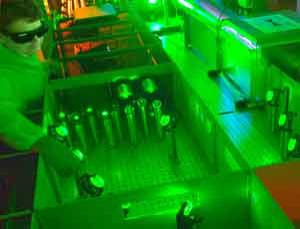Desktop laser accelerators will send the LHC to the dustbin of history
 The scientific community has actively inflamed passions around a giant scientific project called the Large Hadron Collider, which cost us $ 9 billion. Moreover, nuclear physicists have already begun preparations for the construction of a new International Linear Accelerator , even bigger and much more expensive. But for some reason no one says that the same tasks can be done in another way.
The scientific community has actively inflamed passions around a giant scientific project called the Large Hadron Collider, which cost us $ 9 billion. Moreover, nuclear physicists have already begun preparations for the construction of a new International Linear Accelerator , even bigger and much more expensive. But for some reason no one says that the same tasks can be done in another way.The idea of plasma irradiation with powerful lasers was born in 1979 . Theorists predicted that plasma ions could be split in this way, so that light electrons would bounce off in different directions, creating a weak electromagnetic field along the laser beam. Moreover, if the laser is turned off, then the electrons tend back to their places, creating a similar charge of the opposite direction. Thus, with the help of lasers, it is possible to create a wavy structure in space from electromagnetic fields.
It is on these “waves” that the protons are supposed to be accelerated in a laser electron accelerator , and it is possible to achieve enormous acceleration energies at a distance of a few centimeters and “catch” particles directly onto a CCD sensor. An experimental physicist can get proton collisions right on his desktop.
To see the desired effects (miniature black holes, etc.), you need to accelerate particles to an energy of 250 GeV and collide with each other. Previously, the creators of laser accelerators could not exceed the bar even at 1 GeV, but recently there was a real breakthrough: the laser accelerator in California managed to accelerate particles to 85 GeV (though they cheated there a little, but nonetheless)! It remains to learn how to install several laser accelerators in a chain one after another - and then the desired energies can be achieved. It is estimated that such a design will be able to do by 2025.
')
It is not necessary to drive protons through the 27-kilometer European tunnel. The laser accelerator will be relatively compact (at least the size of the laser guns and related equipment does not exceed hundreds of meters).
via New Scientist
Source: https://habr.com/ru/post/48672/
All Articles